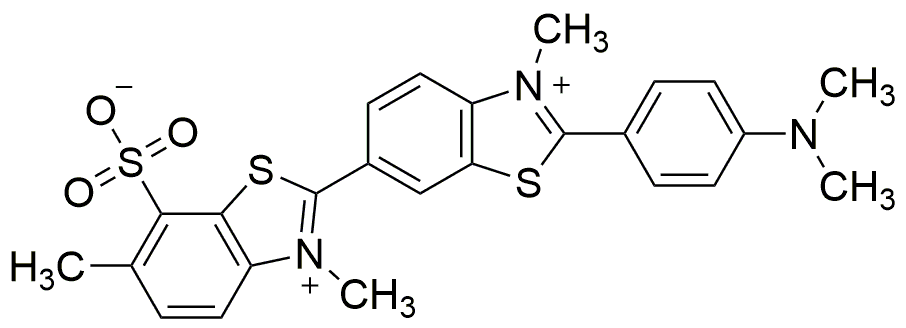Thioflavine S is widely utilized in research focused on:
- Biological Staining: Commonly used as a fluorescent dye to stain amyloid fibrils in biological samples, aiding in the study of neurodegenerative diseases like Alzheimer's.
- Cell Imaging: Employed in microscopy techniques to visualize cellular structures, providing researchers with insights into cell morphology and function.
- Drug Discovery: Used in high-throughput screening assays to identify compounds that can inhibit amyloid formation, which is crucial for developing potential therapeutic agents.
- Environmental Monitoring: Applied in studies to detect and quantify pollutants in water sources, helping industries comply with environmental regulations.
- Material Science: Utilized in the development of new materials, particularly in creating sensors that respond to specific biological or chemical stimuli.
Información general
Propiedades
Seguridad y normativas
Aplicaciones
Thioflavine S is widely utilized in research focused on:
- Biological Staining: Commonly used as a fluorescent dye to stain amyloid fibrils in biological samples, aiding in the study of neurodegenerative diseases like Alzheimer's.
- Cell Imaging: Employed in microscopy techniques to visualize cellular structures, providing researchers with insights into cell morphology and function.
- Drug Discovery: Used in high-throughput screening assays to identify compounds that can inhibit amyloid formation, which is crucial for developing potential therapeutic agents.
- Environmental Monitoring: Applied in studies to detect and quantify pollutants in water sources, helping industries comply with environmental regulations.
- Material Science: Utilized in the development of new materials, particularly in creating sensors that respond to specific biological or chemical stimuli.
Documentos
Hojas de datos de seguridad (HDS)
La SDS proporciona información de seguridad completa sobre la manipulación, el almacenamiento y la eliminación del producto.
Especificación del producto (PS)
La PS proporciona un desglose completo de las propiedades del producto, incluida la composición química, el estado físico, la pureza y los requisitos de almacenamiento. También detalla los rangos de calidad aceptables y las aplicaciones previstas del producto.
Certificados de análisis (COA)
Busque certificados de análisis (COA) ingresando el número de lote del producto. Los números de lote y de partida se pueden encontrar en la etiqueta de un producto después de las palabras "Lote" o "Lote".
Número de catálogo
Número de lote/lote
Certificados de origen (COO)
Este certificado de origen confirma el país en el que se fabricó el producto y también detalla los materiales y componentes utilizados en él y si se deriva de fuentes naturales, sintéticas u otras fuentes específicas. Este certificado puede ser necesario para cumplir con las normativas aduaneras, comerciales y regulatorias.
Número de catálogo
Número de lote/lote
Hojas de datos de seguridad (HDS)
La SDS proporciona información de seguridad completa sobre la manipulación, el almacenamiento y la eliminación del producto.
DownloadEspecificación del producto (PS)
La PS proporciona un desglose completo de las propiedades del producto, incluida la composición química, el estado físico, la pureza y los requisitos de almacenamiento. También detalla los rangos de calidad aceptables y las aplicaciones previstas del producto.
DownloadCertificados de análisis (COA)
Busque certificados de análisis (COA) ingresando el número de lote del producto. Los números de lote y de partida se pueden encontrar en la etiqueta de un producto después de las palabras "Lote" o "Lote".
Número de catálogo
Número de lote/lote
Certificados de origen (COO)
Este certificado de origen confirma el país en el que se fabricó el producto y también detalla los materiales y componentes utilizados en él y si se deriva de fuentes naturales, sintéticas u otras fuentes específicas. Este certificado puede ser necesario para cumplir con las normativas aduaneras, comerciales y regulatorias.

